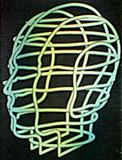HEADCAGE hailed from Leamington Spa, England and formed in the spring of 1990 under the name of “PULP†- an embroyonic project initially attempting to mix an extreme grind sound with a more groovy style. Early members of initial jam sessions were Ed (Kid Carpet) and Nick both from Impaler who provided early lyrics and vocals, Jane was our bass player and Marie on rhythm guitar. The band’s proper line-up was finalised in November ‘90 (Nat - vocals, Ant - Guitar, Paulo - Guitar, Matt - Bass, Nino - Drums) and Pulp had their first gigs in early 1991 with Death Metal bands such as Cancer, Impaler and Decomposed.
Pulp’s ‘Groovy Grind’ music had favourable reviews in metal fanzines after the release of their first two tapes in May 1991. This was recorded in Rob's Caravan of Doom... a VERY basic set-up, but highly enjoyable, none-the-less. With more gigs under their belt, Pulp’s third release was “Beyond Restriction†in February 1992 - a more focused and polished result was obtained, gaining more positive reviews in the underground fanzine press.
The rest of ‘92 and early ‘93 saw a slight name change to Pulp Grind - Jarvis Cocker's Pulp was gaining in popularity and we didn't want to be taking their audience. There was plenty of underground record label interest and many gigs around Britain either with similar emerging bands or often as support to established groups such as Atom Seed. Pulp Grind were on the bill of that year's "Underground Titans" Tour which took in venues in Bradford (with Solstice and Corpus), Norwich, High Wycombe, Banbury (all with Gomorrah), Bridgend (with Corpus and Acrimony) and culminated with a gig at The Marquee in London (with Nightlord).
HEADCAGE was born in July 1993 with the release of two 6-track tapes after an intense period of songwriting. The material on the “Birth/Rebirth†demos began to show HEADCAGE’s experiments with different styles and a move away from their extreme metal origins. This was backed up by the “Naked†tape in November containing a more alternative influence.
1994 was a quiet year for the band, but the release in September of “Visualise†proved to be their strongest and most diverse yet. HEADCAGE was definitely moving in a more unique and positive direction. The band was now fine-tuning all their influences and creating their own ‘HEAD‘ sound. Gigwise, HEADCAGE were moving away from a purely metal audience and often played locally with good friends D•I•S•C.
HEADCAGE’s 1995 (and final) release, “Headâ€, featured a happier and more appealing sound. Recorded at Sable Rose Studios with Andy Faulkner (who would later go on to produce Bolt Thrower albums), “Head†featured all the band members’ varied musical influences, creating a unique style. Despite interest from Sony, HEADCAGE didn’t quite clinch a recording contract and the band consequently split in December 1995.
Headcage's entire back catalogue is now ready to listen to over on my own personal page...
Click Here
Cheers!
Paulo
